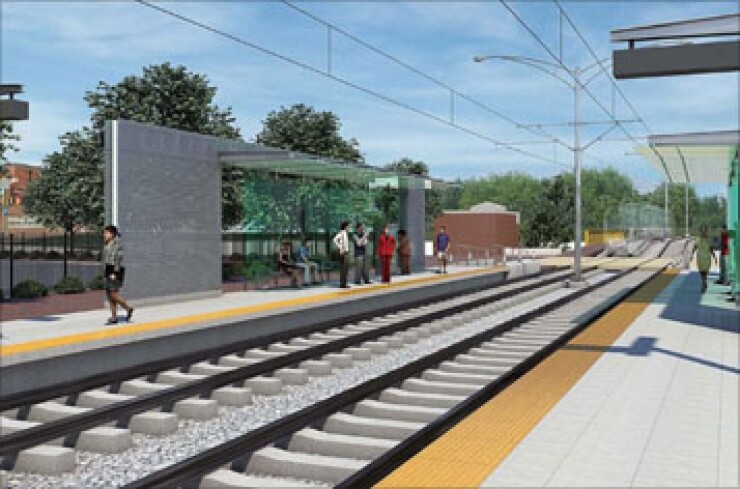
DALLAS -- Baltimore city and county governments will provide $280 million of cash and in-kind contributions for Maryland's Red Line light rail project to help Maryland attract $900 million of federal funding for the $2.9 billion proposed project.
Baltimore County on Tuesday said it would kick-in $50 million and the city of Baltimore pledged $230 million in the joint effort to complete funding for the region's first east-west rapid transit line.
The state requested the local funding in March, with the contributions roughly divided between the city and county based on the number of stations located in each. The 14-mile Red Line will include a total of 19 stations - 15 in the city and four in the county - between western Baltimore County and the eastern edge of Baltimore when it is completed in 2022. Design work is under way, with construction set to begin in 2015.
The project is in line for a $900 million grant from the Federal Transit Administration's New Starts program.
Baltimore's contribution will show the FTA that there is strong local support for the project, said Maryland Transportation Secretary James Smith.
Local funding was instrumental in obtaining the promise of the federal grant, he said, and will help the Baltimore project contend for additional funding.
"Federal funding is not what it used to be," Smith said.
President Obama's fiscal 2015 budget included a request to provide $900 million to both the Red Line project and the similar Purple Line project in the southern Maryland suburbs of Washington, D.C. Each project will receive $100 million in 2015.
The Maryland Transportation Authority, which is responsible for building the Red Line project, said a public-private partnership may help fund the line due to an increase in the cost to $2.9 billion from an earlier estimate of $2.65 billion. The private partner would be given the concession to operate and maintain the line in exchange for an as-yet unspecified investment.
Maryland will build the $2.4 billion Purple Line near Washington through a public-private partnership but a P3 for the Red Line will not be as extensive, state officials said.
The high costs associated with boring the rail tunnel below downtown Baltimore makes it less attractive to private investors than the Washington area project, they said.
The state will release a revised cost estimate for the Red Line project next week in its annual transportation plan update. State funding includes $689 million for the Red Line in Maryland Transportation Authority's six-year capital budget.
The city's contribution to the Red Line's costs will not require new debt or higher taxes, said Baltimore Mayor Stephanie Rawlings-Blake.
"I believe in the Red Line's ability to grow jobs and build Baltimore," she said.
The city's share includes $80 million of cash from federal highway grants and state toll credits, $92 million in property acquisition and utility relocation costs, and the waiver of $58 million in right-of-way fees for the project.
Baltimore County Executive Kevin Kamenetz said in a letter to Smith that the county's cash contribution will include $5 million in 2018 and then $5.6 million a year through 2023. The county will also provide $17 million of in-kind contributions in 2016, including utility relocations and new traffic signals.
The city and county did know until March that they would be called on to help fund the Red Line project, Kamenetz said in his letter to Smith.
"I continue to be disappointed that local governments are now expected to contribute to this project when that was never explained to us during any of the planning stages of the Red Line," he said.
Kamenetz said the county's contribution will be withdrawn if the planned federal funding is not provided or the county stations are not built.
The successful concessionaire for the Purple Line will contribute $500 million to $900 million to build the project. In return, the selected group will receive annual availability payments of up to $200 million a year for 30 years to operate and maintain the Purple Line.





